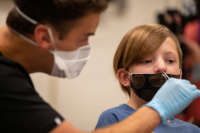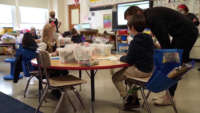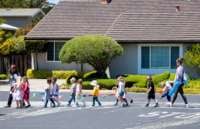As the highly contagious Delta variant continues to spread, many hospitals are reporting record numbers of children being hospitalized, especially in areas with low vaccination rates, including Arkansas, Florida, Missouri and Texas. Dr. Christina Propst, a pediatrician in Houston, says children under 12 who are still ineligible for COVID-19 vaccines are at risk. “They are currently our most vulnerable population, just as this highly transmissible variant is surging across the country,” Propst says. She says Texas Governor Greg Abbott’s order banning mask mandates in schools is a purely political decision that ignores science. “What he is doing is a direct threat to the health and well-being of the children of Texas,” says Propst.
AMY GOODMAN: Many schools are reopening this week. We begin today’s show looking at the rise of COVID-19 infections in children as the highly contagious Delta variant continues to spread. Many hospitals across the country are reporting record numbers of children hospitalized especially in areas with low vaccination rates. The New York Times reports, in a single day last week, Arkansas Children’s Hospital in Little Rock had 19 hospitalized children; Johns Hopkins All Children’s Hospital in St. Petersburg, Florida, had 15; and Children’s Mercy Kansas City in Missouri had 12. Some of the children were in the intensive care unit. This is Dr. Mark Kline, physician-in-chief at Children’s Hospital New Orleans.
DR. MARK KLINE: I have to tell you that I am as worried about our children today as I have ever been. This virus, the Delta variant of COVID, is every infectious disease specialist’s and epidemiologist’s worst nightmare. … As the governor mentioned, there was a myth that circulated during the first year of the epidemic that children somehow were immune. I think there was — there were people who said children don’t get the disease, they can’t transmit the disease. We know that those were fallacies all along, but particularly now that the Delta variant has emerged, it has become very clear that children are being heavily impacted by this organism and by this pandemic at this point, perhaps more than ever before.
AMY GOODMAN: In Florida, where many schools reopen today, the sharpest spike in COVID cases has recently been in children under the age of 12. As of Sunday, Florida had 172 children being treated in hospitals for COVID — the highest number in the country. This comes as Florida’s Republican Governor Ron DeSantis is threatening to defund the salaries of school officials who mandate mask wearing in schools. Several counties have announced mask mandates in schools in defiance of DeSantis.
A similar battle is brewing in Texas, where school authorities in Dallas and Austin are requiring masks in defiance of Republican Governor’s Greg Abbott’s order. This comes as pediatric wards in Houston are nearing or at capacity. One 11-month-old baby in Houston was recently airlifted to a hospital 170 miles away because there was not enough space to get treated in a Houston hospital.
So that’s where we’re going, to Houston, where we’re joined by Dr. Christina Propst. She is a physician, a pediatrician at a private practice and a member of the American Academy of Pediatrics’ Council on Children and Disasters. She is also a member of the Texas Pediatric Society Committee on Infectious Diseases and Immunizations.
Dr. Propst, thanks so much for being with us. Can you start off by explaining what the Delta variant has to do with this increased number of children being hospitalized? Why are they so particularly vulnerable right now?
DR. CHRISTINA PROPST: Right now we are in an unfortunate situation where the Delta virus is prevalent. The Delta variant of COVID-19 is the prevalent circulating variant in this country. It is more easily transmissible, and, notably, more easily transmissible to those who are unvaccinated. And as I’m sure you and your listeners know, children under age 12 are currently still ineligible to be vaccinated against COVID-19. They are currently our most vulnerable population, just as this highly transmissible variant is surging across the country, notably in Texas, in Florida, in Louisiana, in Arkansas, Missouri and many other states.
JUAN GONZÁLEZ: And, Doctor, could you talk about also the issue of long COVID in children? There have been reports that many children are suffering from lingering physical, mental and neurological symptoms as result of sometimes an infection that is very mild or asymptomatic.
DR. CHRISTINA PROPST: Absolutely. That is one of the greatest concerns, I would say, for pediatricians, and, frankly, should be one of the greatest concerns for parents across the country right now. There is a condition, as many people have heard, called long COVID. It was originally identified in adults, mostly because adults were getting tested. From day one, children have been undertested in this country. So, long COVID, now also known as post-acute sequelae of COVID-19, is a condition that can arise weeks to months later and generally involves a constellation of symptoms, including the brain fog many people have heard of, aches, low-grade fevers, a malaise that just won’t go away, a lack of energy.
And unfortunately, we are seeing more and more long COVID, which can be truly debilitating, in young children. We are seeing that as the incidence among the pediatric population increases, we are starting to see those long COVID cases, so the malaise and fatigue that just does not go away, six, eight, 10 weeks after an acute COVID infection, which might even have been a mild infection. The vast majority of children do not require hospitalization for COVID-19. However, that does not mean they are safe or somehow immune from long COVID or from multisystem inflammatory conditions that can occur post-COVID infection.
JUAN GONZÁLEZ: And could you respond to Texas Governor Abbott’s having issued a ban on school masking mandates?
DR. CHRISTINA PROPST: It’s so frustrating, as a pediatrician and as a parent. I feel for parents who are making these difficult decisions right now, whether to homeschool. Many school districts do not offer a virtual option this year. Many have done away with the plexiglass and some of the other COVID-mitigating modes and modalities in their classrooms. Our governor, unfortunately, has taken our children’s lives and is using it in a political game of chicken. That’s really the best way to describe it right now.
I’m thrilled to see Houston Independent School District, our new superintendent, Millard House, last week announced intention to issue a mask mandate in our huge public school system here in Houston. Dallas has followed. Austin has followed. Other districts are now starting to try to come up with a virtual option. Masks are the last best hope of defense for children who are vulnerable, and that includes every single child under age 12 right now.
Unfortunately, it also includes a huge proportion of our population of school-age children who are eligible, who are between ages 12 and 17. Currently only 30% of tweens and adolescents in that age group are fully vaccinated. And so, pediatricians across the country and the American Academy of Pediatrics are begging parents to get their children vaccinated before the start of school.
AMY GOODMAN: Would you say, Dr. Christina Propst, that the governor is threatening the health of the children of Texas?
DR. CHRISTINA PROPST: I would say what he is doing is a direct threat to the health and well-being of the children of Texas. Unfortunately, also we need to keep in mind that for some Texans who can afford to send their children to private school, this might not be a problem. Private schools have issued mask mandates. Private schools are doing pooled testing and screening for symptoms. This will disproportionately affect, in every way, health, mental well-being, education, the most vulnerable students among the most vulnerable of our population. And so, that includes our unvaccinated children under age 12 who are in perhaps the poorest performing, oldest schools, with the most overcrowding, with the oldest school buildings, with the poorest ventilation. Those children have a disproportionately high incidence of some comorbidities that even put them at higher risk — asthma, a high BMI or obesity. So, those children absolutely will be disproportionately affected by this purely political and unfortunate decision by our governor.
AMY GOODMAN: Dr. Christina Propst, we’re going to break, then come back to this critical discussion about children and COVID, why it’s not only surging — COVID is not only surging in the United States among children, and also among the unvaccinated population overall, but around the world, as well. Dr. Christina Propst is a pediatrician at a private practice in Houston, member of the American Academy of Pediatrics’ Council on Children and Disasters, member of the Texas Pediatric Society Committee on Infectious Diseases and Immunizations. We’ll be back with her in a moment.
[break]
AMY GOODMAN: “Sea of Tranquility” by Kool & the Gang. Co-founder Dennis “D.T.” Thomas died this week at the age of 70.
This is Democracy Now!, democracynow.org, The War and Peace Report. I’m Amy Goodman, with Juan González. As we talk about children and COVID, we turn to top White House adviser Dr. Anthony Fauci, who was speaking on NBC’s Meet the Press about the rise of COVID infection in kids and what can be done to protect them from the virus.
DR. ANTHONY FAUCI: There is a problem with children. You’ve got to separate and make sure you get the facts. The likelihood of a child getting serious disease compared to an elderly person or someone with an underlying condition is absolutely less. But less doesn’t mean zero. And there are a lot of children now — all you need to do is do a survey of the pediatric hospitals throughout the country, and you’re seeing a considerable number of young people who are not only infected, but who are seriously ill. Again, the numbers compared to the elderly are less, but that’s a false comparison. These kids are getting sick. We’ve really got to make sure we protect them. …
There are two things you do with children who are not vaccinated, and that’s the recommendation. You surround them with those who can be vaccinated, whoever they are — teachers, personnel in the school, anyone. Get them vaccinated. So, protect the kids with a shield of vaccinated people. For the kids who can’t get vaccinated, that’s the reason why we’re having a strong recommendation that, in the schools, everybody should wear a mask, whether or not you’re vaccinated.
AMY GOODMAN: So, that’s Dr. Anthony Fauci. We’re talking to Dr. Christina Propst. She is a Houston pediatrician, member of the American Academy of Pediatrics’ Council on Children and Disasters, member of the Texas Pediatric Society Committee on Infectious Diseases and Immunizations. You have, in Houston, hospitals filling, in Austin, in Dallas. An 11-month-old is taken on a plane 150 miles away because there wasn’t room for them in the Houston hospital. Can you talk about what parents have to look for? If you can’t — what are the symptoms? Are they different in infants, in young children? And also, Texas, Arkansas, Florida, huge unvaccinated populations, but in places like New York, the vaccination rate is very high. How concerned should parents be here?
DR. CHRISTINA PROPST: So, to address your first question, the presenting signs for COVID in children can really vary. I have treated children as young as 5 weeks old, and I have treated teenagers, 16-, 17- and 18-year-olds. Obviously there is a huge range of how those individuals can respond, even can articulate how they are feeling. So, for some children, it can be abdominal pain. And I have seen children, school-age children, for whom significant or even severe abdominal pain was really the presenting sign. Then they developed fever. Some have not developed fever at all. Many develop upper respiratory symptoms. So, I would say the majority of patients that I have seen have had cold-like symptoms — congestion, cough, sore throat, low-grade fever, sometimes then elevating fever a few days in. Some pediatric patients, of course, do lose their sense of smell and their sense of taste, as well. So, it’s really a variety of symptoms.
And parents and pediatricians, of course, need to have a very low threshold right now for testing and for getting a quality test. There are still tests out, that are widely circulating, that have a very high false negative rate. That’s not helpful to anyone. So, getting tested frequently, certainly as soon as symptoms are setting in — if we know there’s been an exposure, getting tested several days out, if you are asymptomatic — and getting a quality test truly is important.
There certainly are parts of the country where the vaccination rate is significantly higher. Now, we need to remember, cohorting among a group of adults, let’s say, in New York City, where the adults have a very high vaccination rate, and possibly even the teens and tweens, although it is significantly lower than the adult population, is not enough to protect our young children under age 12 from the Delta variant of COVID-19. It’s simply not going to do it. There is enough travel. There is clear data showing vaccinated individuals can transmit the virus to the unvaccinated. So, if you have an adult in a household who is vaccinated in New York City who’s hopped on a plane where someone with the Delta variant took their mask off to eat or drink, that person could be harboring the virus, could be asymptomatic or have a very mild infection, where they think it’s allergies, and pass it on to their child. And even a mild infection in children — we need to remember this — even a, quote, “mild” or moderate infection with COVID-19 still puts that child at risk for long-haul COVID and for multisystem inflammatory conditions. So, that is a key takeaway right now, that even areas with a high vaccination rate among adults, children there are still incredibly vulnerable.
JUAN GONZÁLEZ: And, Dr. Propst, I’d like to ask you about a surge in another virus called RSV. Could you tell us what you’ve seen of that virus? Is there a connection between it and COVID? And why has there been a sudden surge in RSV?
DR. CHRISTINA PROPST: So, RSV is a virus that many parents are not familiar with, and it is — it stands for respiratory syncytial virus. In the pediatric community, it is notorious. It tends to run in tandem with flu season. It tends to be a wintertime virus that predominantly affects young children, babies, particularly premature babies. They can have respiratory distress and even respiratory failure. Here in the state of Texas, typically, the state stops monitoring, stops even counting, cases of RSV in late May or June. This year, they didn’t stop. In fact, our surge occurred afterwards. Our surge really has been June, July and August, which is unprecedented for this viral infection, at least in the 20 years that I’ve been in practice here in Houston. So, it is highly unusual.
There doesn’t appear to be a direct relation between COVID-19 and RSV per se. The respiratory syncytial virus by far predates SARS-CoV-2, which is a novel or new coronavirus. So, it is unclear why RSV is surging right now. It’s also notable that in an area such as Houston and in Texas, where RSV right now is surging and rampant, flu really is not — and I knock on wood as I say that. Certainly people are vaccinated against influenza; however, the vaccine efficacy from last season would have waned significantly by now. And so, with those viruses generally running in tandem, one would have expected flu also to be at least increased, if not surging.
So we are really in a perfect storm down here. And other states are facing this, as well, certainly. RSV hospitalizations are at a level I’ve never seen at this time of year. I have personally had to hospitalize more babies with RSV respiratory distress, and some who developed respiratory failure and had to be intubated and in the intensive care unit for over a week due to RSV, more in the past two months than I have in the previous three to four years.
AMY GOODMAN: Finally, would you send — do you have school-age kids or younger?
DR. CHRISTINA PROPST: I have college-age kids.
AMY GOODMAN: If you had younger kids, whether you’re in Texas or New York, would you send them to school?
DR. CHRISTINA PROPST: If my children were under age 12 and in a schooling situation such as public schools right now in Texas, where our governor has banned mask mandates in a school setting against the recommendation of the American Academy of Pediatrics and Centers for Disease Control, I would be seriously looking at other options, whether that is homeschooling, virtual option — for those who can’t afford it, let’s say, a private option. Unfortunately, that is not reality for the vast majority of students.
AMY GOODMAN: We want to thank you for being with us, Dr. Christina Propst, pediatrician —
DR. CHRISTINA PROPST: Thank you.
AMY GOODMAN: — private practice in Houston, member of the American Academy of Pediatrics’ Council on Children and Disasters, as we continue on the issue of schools, but now we’re going to talk about teachers.


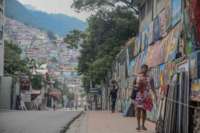
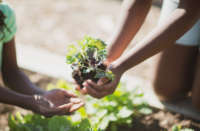
 A place that should safeguard him and enable him to learn and thrive. Police have no business being in schools.
A place that should safeguard him and enable him to learn and thrive. Police have no business being in schools.  That was so heartbreaking to watch. All the more reason not to have police in schools
That was so heartbreaking to watch. All the more reason not to have police in schools

 #Black Lives Matter
#Black Lives Matter  #Windrush (@doloreselee)
#Windrush (@doloreselee) 
 (@VikCR_)
(@VikCR_) 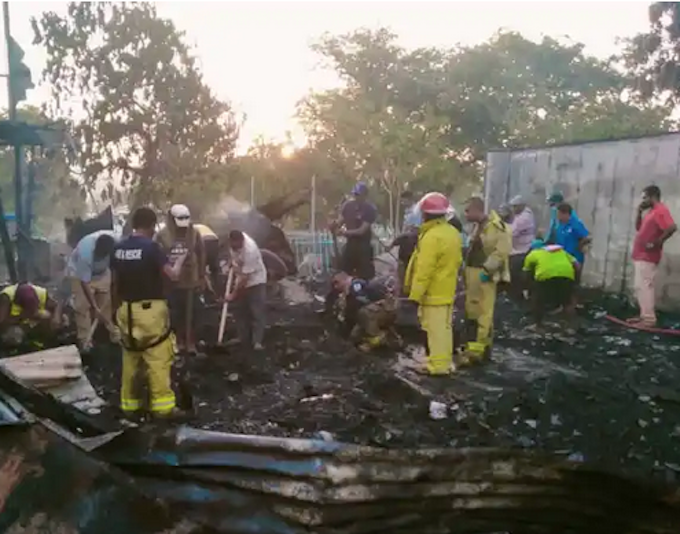
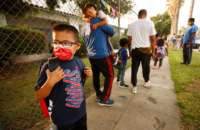
 (@DeptofDefense)
(@DeptofDefense) 
 (@richimedhurst)
(@richimedhurst) 
